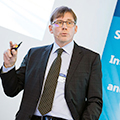Preparations for the Fehmarn fixed link are well advanced
Comprehensive planning work, along with feasibility and environmental studies have been carried out in connection with preparations for the construction of the Fehmarnbelt tunnel.
The project is divided into several phases. This will ensure an efficient and continuous building process.
Site preparation, construction of the production facilities and associated working harbours will be the first phases. The next steps is to carry out a dredged trench from Denmark to Germany and building the portal facilities, before production and assembly of the tunnel elements.
The tunnel elements will be produced at a production facility near by and towed out to the Fehmarnbelt on an ongoing basis. Contractors will immerse the elements one by one and assemble them from the coasts and out toward the middle of the belt from both the Danish and German sides.
The next steps is to install the technology and equipment before testing and opening.
Most of the dredged soil from Fehmarnbelt trench will be used to build new recreational areas of the coasts of Lolland and Fehmarn. The new landscape will be shaped by beaches and dunes as well as both wet and dry natural and grazing areas of both recreational and biological benefit.
In operationm, there is a minimised the risk of serious accidents through the way in which the tunnel is designed and via its technology and equipment.
All tunnel tubes are connected by emergency exits every 110 metres, where it is possible to pass from one tunnel tube to the other via the emergency exits.
The tunnel has two tubes for rail traffic and two tubes for road traffic. There is also a technical service gallery between the two road tubes.
The tunnel is also equipped with advanced traffic monitoring equipment that can detect different scenarios, lost objects, slow vehicles, congestion and traffic in the wrong direction. All areas in the road tunnel tubes are video monitored and the Traffic Control Centre will monitor all traffic 24/7.
Approximately every two kilometres of tunnel, the main technical facilities and equipment for operation and maintenance will be located in a wider section. Because of this, the Fehmarnbelt tunnel will be more efficent to maintain and will require significantly less building materials in the main part of the tunnel. A design that will influence reliablity, availability, maintainabailty and safety in a positive way.

 En
En 
